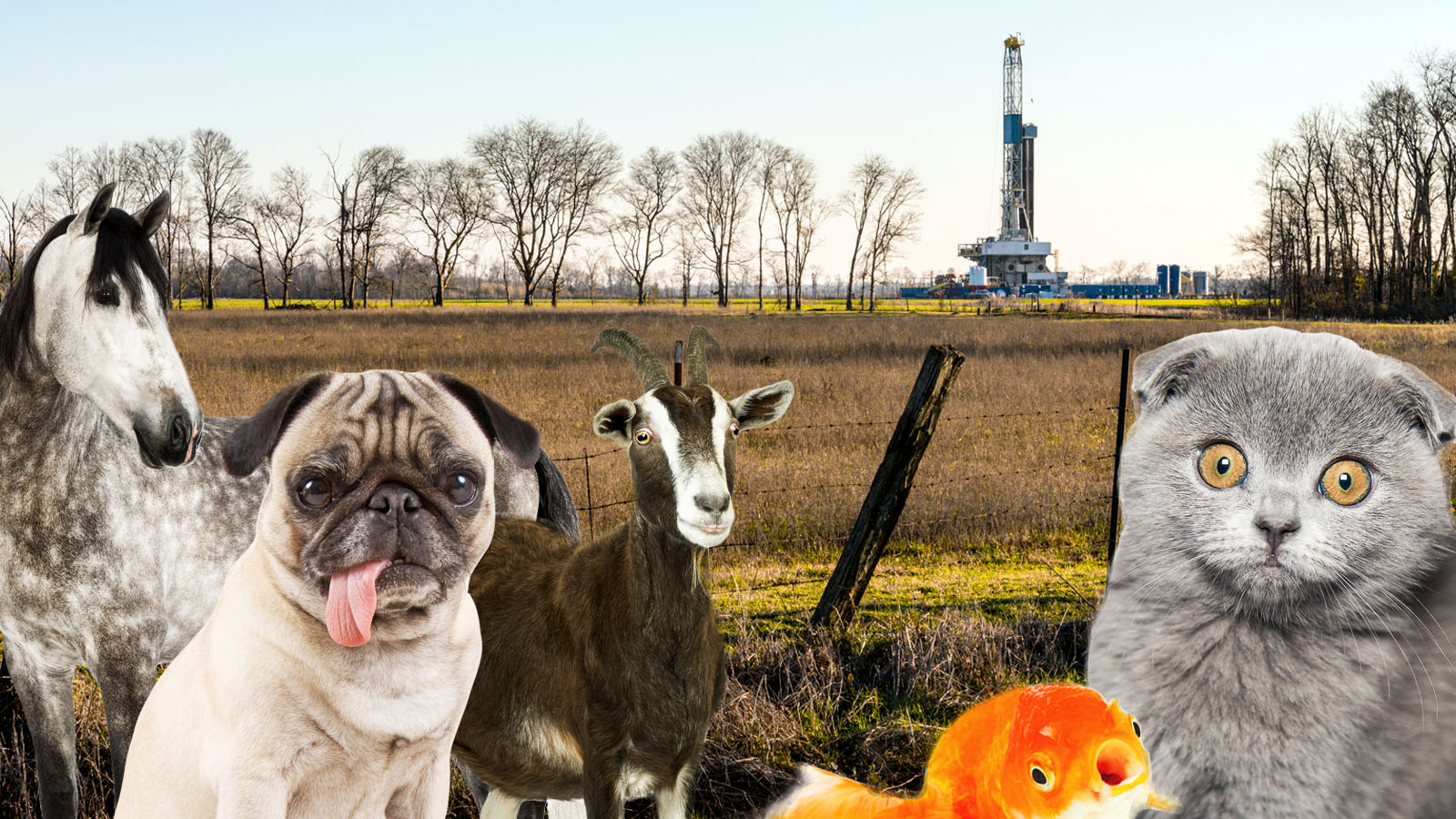Fracking can ruin a lot of things: landscapes, rivers, ecosystems, the climate, your health and safety and that of your family. But have you thought about how it could hurt that other great American institution — the household pet?
Humans love their domesticated animals so much that the cumulative weight of the beasties overwhelms that of Earth’s other land mammals by several orders of magnitude, including humans. (Granted, cows make up a hefty chunk of that poundage, but dogs and their ilk are undeniably popular in the U.S.) In an upcoming book called The Real Cost of Fracking, veterinarian Michelle Bamberger and Cornell professor Robert Oswald take on the question of how fracked our pets are, as well as the wider effects of natural gas extraction. To keep from hyperventilating with panic (and/or respiratory distress resulting from fracked-up air quality), let’s focus on Fido for now.
Disclaimer: While it’s difficult to prove that fracking causes any of the mysterious, unprecedented, terrible things that happen in rural America exactly when gas companies comes to town, Bamberger and Oswald do just fine with correlation, gathering sad anecdotes of frack-adjacent people and their ailing pets around the U.S.
Hold on to your gerbils, folks, this is going to be a bumpy ride.
Your pets have the most exposure time.
Spot may run, but he rarely runs into town for groceries or a movie. He is there, in your house in downtown Fracktown, day in and day out. If methane or hydrogen sulfide or other nasties seep into the air, your pup is probably going to breathe more of it than you are.
What about your pet canary? No need to head to a coal mine to start measuring your toxic environment!
Your pets better get used to diesel fumes.
When gas operations move into a town, trucks fume up and down the formerly quiet country roads that your golden retriever frequents. Those diesel belches are full of benzene, a carcinogen that is dangerous for dog AND his best friend.
Your pets are smaller than you, therefore weaker.
Less body mass means a smaller dose of pollution packs more wallop. If you like to cry, you can find videos online that claim to show cats and other animals with apparent neurological damage from airborne fracking. (All right, here’s one — but don’t say I didn’t warn you.) Even larger animals can accumulate poisons quickly; Bamberger reports on healthy dogs and horses whose kidneys failed, a possible result of ingesting heavy metals or radioactive materials. Hear that, Misty of Chincoteague? You and Black Beauty better stay away from that aerosoled, irradiated wastewater.
I hope you don’t like puppies or kittens.
Baby animals are even more vulnerable to environmental toxins. In some fracking towns, people have reported stillbirths and infant mortality among pets — as well as other cutesy farm critters, like calves, foals, and baby goats. Oh yeah: This may apply to baby humans, too.
Your pets are probably not drinking bottled water.
Although we’re normally not big fans of bottled water, if your backyard well is within reach of fracking operations, you’re probably better off with the stuff. But does Kitty get to drink Dasani, too? Does Kitty occasionally lap water from puddles outside, where surface spills or intentional wastewater dispersal have taken place? Does Kitty have a death wish?
Your pet fish are screwed.
Unless you’re likely to fill a 50-gallon tank with Poland Spring, your tropical fish hobby could take a hit when your tapwater comes laced with fracking fluid. Ditto that koi pond you carefully stocked last year. In fact, wild fish kills in rivers near fracking operations are also frequent, the result of spills or toxic algal blooms or even just low water levels after creeks are drained to power the thirsty industry.
You can’t prove anything.
You may not know what is in the air or the water near fracking sites, thanks to proprietary secrets and poor monitoring. Of course, you can test your own water or air if you have a cool coupla Gs to shell out, but most people rely on industry to police itself. Even if you find the presence of a toxic substance in your tap, it could be hard to prove how it got there. So if your cats and dogs start dropping, good luck with that smoking gun.
Some hazards may include: hydrogen sulfide released during well-drilling; methane that escapes from equipment during extraction; mysterious fracking fluid that seeps into the water table; or the wastewater that flows back to the surface with whatever it happened to absorb from the underworld, and is often spread on roads or left to evaporate in ponds.
So, to sum up, if your pets perform any of the following activities in a shale-rich region, they could be in trouble: breathe air, drink water, enjoy being alive.



